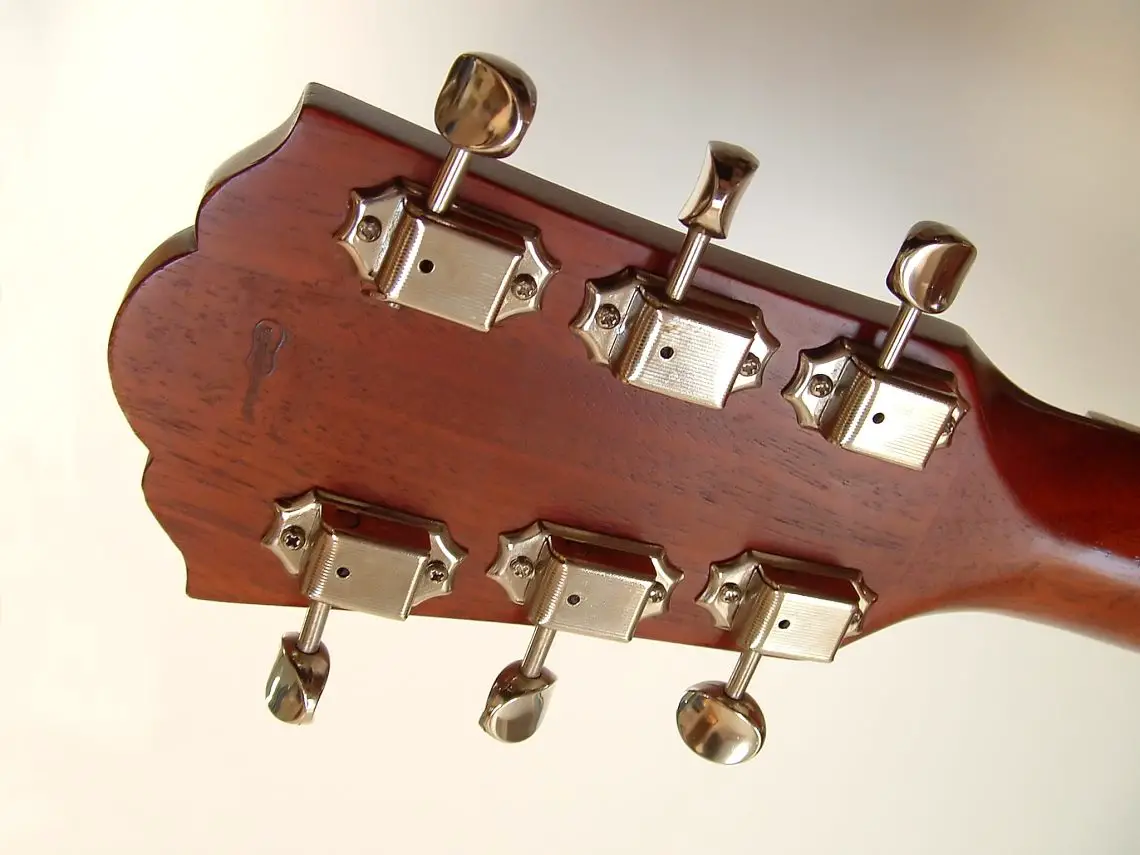If you are a musician and don’t happen to possess perfect pitch, a tuner will be an essential tool for your performances.

Credit: MUSIC Group Innovation DK A/S
Top Pick: TC Electronic PolyTune 2
This true bypass tuner is durable and extremely precise, and the strobe display mode allows you to see all six strings at the same time, showing you which ones are flat, sharp, or in tune.
You need to find one that is fast and easy to use, so it is important to do some research and see what tuners will work best for your needs. Here are a few tips on buying a tuner, and a few reviews to help you start your search.
Types of Tuners
There are a lot of choices when it comes to tuners for a guitar or bass that range from simple tuners to complex devices.
Electronic tuners – You will find a wide variety of electronic tuners that you can use with a guitar. Some will detect the vibration of each string to help the guitarist get in tune. Other tuners will use both of the methods of tone detection.
Tuning forks – When you strike a tuning fork, you will hear the “A” note. You can then tune your string to that pitch, and then tune the rest of the strings in relation to the A string. This can be a challenging process for students, and it is also hard when performing in a noisy setting.
Pitch pipes – When you blow a pitch pipe, it will emit six different tones that correspond to the six strings on a guitar. This is also challenging for students, and it is difficult to do in a noisy setting.
Tone generators – These can be used when you are tuning acoustic instruments like brass, wind, percussion, or stringed instruments. Tone generators include tuning forks and pitch pipes that were created to be used with a specific instrument like a violin, cello, or ukulele.
Chromatic tuner – This type of tuner can also tune an acoustic instrument – if it is outfitted with a microphone that can detect the sound of the instrument. These devices come with a wide variety of features that are sometimes adjusted to work with specific instruments or instrument families.
Types of Electronic Guitar Tuners
Clip-on or headstock tuners – This type of tuner clips onto your guitar or bass headstock, and it can detect each string’s tuning through the vibrations of the instrument. Some of these clip-on tuners have an internal mic that permits the acoustic tuning of a wide variety of instruments. It is typical of them to be able to swivel, so that you can see them easily, and some of them are created to work alongside stringed instrument and other assorted wind and brass instruments.
Pedal Tuner – This type of tuner is housed inside a case that you can rest at your feet, making it perfect for discreet use by a performer. They have displays that you can read easily in a dark venue.
Multi-Effect Pedals – Many of these types of pedals come with tuner capabilities as one of their function.
Rack and Tabletop Tuners – There are many types of these tuners on the market with features to fit your needs and price points that will fit your budget. Some are very sophisticated, and they are used in stage rigs and studios. Other simpler tuners will be able to give you all of the basic tuning functions that a guitar will need without a lot of added features.
Built-in Preamp Tuners – Preamplifier circuits of some acoustic-electric guitars and a couple of electric guitar models have a tuner built into them. There also some guitar amplifiers that come with a tuner function. Since they are built in, they are extremely convenient, and some even let you tune silently, which is helpful when you are performing, or are in a noisy setting.
Apps – There are also many apps that you can download if you have an iOS or Android smartphone that will let you perform chromatic and guitar tuning. These tend not to be as accurate as the other tuners.
Features and Functions
It is important to know what features are available on current tuner models that are on the market, and whether or not you need those features with playing style and skill level. Make sure to do your research and keep your budget in mind while you are shopping.
Displays/meters – One of the most important features of a tuner is the ability to see the information that the tuner is giving you. If this information is not legible or clear, the tuner is not really helping you. Some models have a needle-based meter that will show you how close you are to the pitch while you are adjusting the tension on your string. Some use LCD displays with a needle-like graphic or a LED light that will change colors as you get closer to the right pitch.
Many of these displays will also use colors to show that you are flat or sharp, and they will display the string that is currently being tuned. Many of them can even help you fine tune your guitar or bass, and some of the most advanced models use strobe technology that shows you in real time. Always think about where you are playing and consider whether having a brightly lit display will help you on a poorly lit stage.
Auto pitch detection – Some of the high-quality tuners will tune automatically, identifying the played tone and indicating how relative it is to the true pitch. Lesser-quality models will require you to set a target pitch for each of the strings.
Special tuning modes – Optional tuning modes on many digital guitar tuners can match certain instruments like a baritone and 7-string guitars or 6-string basses. Some of these tuning modes also back drop tunings based on “D” or “Eb”, popular in rock and heavy metal and rock, instead of the typical “A” reference. Look for a tuning model that supports capo tunings if you use a capo. Also, it is possible to find a lot of alternate tuning modes as well as various tempered scales on more elaborate guitar tuners.
Microphones and speakers – Microphones that are placed on tuners will distinguish an instrument’s acoustic tuning. This is convenient for a wide variety of instruments, especially those that have a built-in amplifier and speakers that make audible tones – handy when you are developing an ear for intonation.
Metronomes – Many tuners also have a metronome function that makes them perfect for students.
Bypass/silent tuning – The bypass features of pedal tuners doesn’t color the signal that it send to the amplifier. Silent tuning avoids the amplifier’s output or sound system, and it lets you tune by just referencing the visual display on your tuner.
The Competition
After hours of testing and research, here's the final competition.
| Instrument | Rating | Current Pricing |
|---|---|---|
TC Electronic PolyTune 2 | Allow you to see all six strings at the same time |  |
Sonic Research Turbo Tuner ST-300 |  |
|
Korg Pitchhawk-G | Has a clear and bright display that can be seen from any angle due to its movable arm and ball joint |  |
Boss TU-3 Pedal Tuner | Display with a high brightness mode that has a maximum current draw |  |
Korg Pitchblack Poly | Precise tuning in a single strum of the guitar |  |
Snark SN-8 Clip Tuner | Most recommended brand of clip-on tuner |  |
Peterson iStrobosoft HD | has all the options available on the main screen |  |
Top Pick: TC Electronic PolyTune 2

Credit: MUSIC Group Innovation DK A/S
The TC Electronic PolyTune 2 is a true bypass that is an extremely precise tuner. It will allow you to see all six strings at the same time, and it will show you which ones are flat, sharp, or in tune. It can also be drop-tuned to B, and capo-tuned up to the 7th fret (B-B). The new ultra-accurate strobe display mode can tune to 0.1 Cent accuracy and ideal for setting your intonation.
The PolyTune allows you to access a variety of modes and tunings with two buttons that are found on the top of the pedal. Once you have chosen your settings, the tuners will remember your combinations, even if you turn it off. The strobe function is also very precise making the PolyTune one of the most recommended tuner pedals on the market.
It is a great size for a tuner with just the right size to see the display, but not so big that it takes up a lot of space. It is also durable and built well, so it is perfect to take out on gigs.
It also features a soft click when you turn it on and off instead of that annoying loud, jarring click that many footswitches have. The footswitch is a real bypass keeping your tone unaffected while the tuner is off. There are inputs and outputs on the sides of the pedals for your guitar cables, and the rear of the pedal has a 9V DC power supply jack. The optional power supply lets you daisy chain and power other pedals. There is also a SUB port on the read of the pedal to download the firmware updates from TC Electronic.
The PolyTune not only looks good and has a great display, but it also tunes well. You can watch the pedal cycle through various options on the display button on the back of the pedal. Touring professionals will love the strobe tuner that can tune to +/- 0.1 cent tuning accuracy. The Tuning Magnet feature lets you get as close as possible to the correct pitch, and you can see the really steady needle indicating the accuracy.
It also features an auto-sensing light option that eliminates the need to wear sunglasses when you are tuning in a normal setting. The display is bright and easier to read since it is made up of over 100 LEDs, and there is an ambient light sensor that will change the brightness making it easier to read depending on where you are, making it great for outdoor gigs.
The PolyTune is available in the very affordable 
Pros:
- Has a bright display that can be used outside on a sunny day
- Has an accurate strobe mode, and simultaneous tuning
- Nice tuner, very accurate
Cons:
- Can’t alter your reference pitch from A-440
Runner Up: Sonic Research Turbo Tuner ST-300

Credit: Sonic Research Inc
The Sonic Research Turbo Tuner ST-300 is advertised as a “true stroboscope” tuner that is very precise, but it is not widely available. A mechanical strobe tuner operates with the input guitar signal driving a strobe light that will light up a rotating disk. When the guitar signal frequency equals the rotating disk speed, the rotating pattern will look like it is standing still indicating that the tuning of the note is correct.
The slightest discrepancy is shown by a strobe tuner between the reference frequency and the note you are playing making it a lot more precise than the needle type of tuner. The only difference between a mechanical strobe tuner and the ST-300 is that the ST-300 does not have a rotating disk.
The Turbo Tuner ST-300 is durable and it has a utilitarian appearance, but it gives the look of more usability instead of just a neat gadget. It has a die-cast aluminum MXR-style with a true bypass footswitch. There is a ¼” IN and OUT jack on each side, and the output is muted when you are operating the tuner. There is a jack for the optional 9V DC power supply on the rear of the pedal, and the power supply allows you to power other pedals and create a daisy chain.
You will also find a micro USB port that will allow you to do customized tunings on your computer. You can also alter your tuning setting with the CAL and FLAT modes of operation.The Sonic Research Turbo Tuner ST-300 gives you +/- .02 cents accuracy, which is the best you can get with a pedal tuner.
It has a bright display, but not bright enough for extreme conditions. The LED pattern will rotate right is your note is sharp, and rotate left if your note is flat. When the pattern does not move, your note is in tune. If you are used to the needle-type of tuner, this strobe-style display will take a little getting used to. The CAL button is also available to change the A4/440.0 Hz reference frequency if you prefer.
The ST-300 has several customizable features, and it can assist with several temperaments including just, equal, and Pythagorean, plus alternative tunings like drop D, open D, open A, and DADGAD, 5 string bass, violin, cello, bass, and bass drop D.
You can also make setting adjustments that can take more time by pressing mode buttons when the pedal is powering up. You just need to remember the right order of button presses. Most importantly, it will remember your settings once it is turned off. This is a super-fast tuner with zero lag.
Pros:
- Very responsive and accurate
- Will remember your settings once it is setup
- Super-fast tuner, notes appear immediately
Cons:
- Needle type tuner
Other Products to Consider:
Korg Pitchhawk-G

Credit: KORG Inc
The Korg Pitchhawk-G is a headstock tuner that has hawk-like tracking. This tuner has a clear and bright display that can be seen from any angle due to its movable arm and ball joint. The sturdy rubber-cushioned grip keeps it from falling off your guitar, and it has lightning-fast accuracy with a +/- one cent accuracy.
You will also be impressed with the capo mode and automatic power off modes.
The Korg Pitchhawk-G is available for 
Pros:
- Has a great display with a movable arm and ball joint
- Simple to use with a great price
- Highly adjustable and sensitive tuner
Cons:
- Pretty big size
Boss TU-3 Pedal Tuner

Credit: Roland Corporation
The Boss TU-3 pedal tuner is one of the best-selling stompbox tuners in the world, and it has been updated from the previous TU model. Boss created an industry standard with the TU-2 pedal with a +/- 3 cent accuracy and limited display, and when other brands provided better specs, they decided to do an upgrade into the TU-3. The TU-3 has a +/-1 cent accuracy with an over 23-segment LED display.
This upgrade definitely is more accurate, and, when tested, has outperformed its predecessor, especially live on stage. It is also much better when you are adjusting your intonation, and it has drop tuning that is up to six semitones with bass tuning up to three flats.
The Boss TU-3 has a display with a high brightness mode that has a maximum current draw that has gone up from 55mA (TU-2) to 85mA. It has a great build quality and form that most will see as just classic Boss, but it definitely is a reliable pedal that is great to take out on tour. It has the simple on and off switch that you just press down, and a ¼” input on one side for your instrument with two outputs on the other side.
While you are tuning, your output is muted, which is great for a live setting. The 9V DC power supply can power up to seven Boss compact pedals, so you can daisy-chain to it. It also comes with two buttons under the display control that gives you variable functions including a STREAM/CENT button, plus a MODE button.
Tuning with the Boss TU-3 will be no issue. You can tune a guitar or bass using various tunings, or tune a 7 string guitar or 6 string bass. You can adjust the brightness of the 21-segment LED display in case you are in harsh lighting and you are having difficulty seeing it.
When you are tuning and you get close to pitch, the display will let you know how close you are with red and green markers as well as yellow arrows. You can switch between CENT as you get closer to center, and STREAM where the lights slowly flow as you get closer to pitch.
You can switch between Chromatic Flat, Chromatic, Bass, Guitar, Guitar flat, and Bass flat modes with the MODE button.
The Boss TU-3 is available for 
Pros:
- Great price with a high brightness mode
- Very accurate, easy to use
- Simple and classic tuner
Cons:
- Has a slow response
Korg Pitchblack Poly

Credit: KORG Inc
The Korg Pitchblack Poly gives you precise tuning in a single strum of the guitar. With just one strum of the open strings, the Pitchblack Poly can automatically tell if you are playing guitar or a bass, even four-, five- or six-strings, and it can tell you how in tune you are with the clear display.
At this point, you can tune each of the strings separately, and the display will show you the note that you are trying to achieve. The meter can be set to strobe, half-strobe, regular, or split, and you can also calibrate the tuner so it will work with different capo and alternative tunings.
The Korg Pitchblack Poly is one of the better tuner pedals on the market as it is very accurate and super easy to use with an affordable price tag. It is very durable and is housed in an aluminum case that appears indestructible. It only has one plastic part – the battery door on the rear of the pedal.
The front of the pedal has a footswitch to turn it on and off, and it is a true bypass. You ¼’ jack for instrument cables go in either side of the pedal, with the 9V DC jack going in the back. The 9V DC output jack allows you to daisy chain several pedals and power them all through Pitchblack.
Korg Pitchblack tuning is very easy and simple to understand. You just plug in your instrument, and while you are tuning, your output is muted. You will see four modes with the Display button that includes Meter, Mirror, Half Strobe, and Full Strobe. These modes help you get to the right pitch, and most people just use the default mode.
There is +/- 1 cent detection accuracy making tuning crisp, and there are yellow arrows that will indicate if you are flat or sharp, plus red and green arrows that will reveal how close to pitch you are. The process is very smooth and not at all jumpy.
The display is large and bright, and you will be able to see it no matter what the lighting conditions. You can also calibrate the tuner from 436 Hz to 445 Hz.
The Korg Pitchblack is available for 
Pros:
- Easy to use, accurate tuner
- Very compact, straightforward tuner
- Easy to read and durable
Cons:
- Slow to register notes, will reset settings when you unplug it
Snark SN-8 Clip Tuner
Sam Ash Quikship CorpThe Snark SN-8 is a clip on tuner that is attached to the headstock, and it works based on the vibrations from the instrument. Snark is the most recommended brand of clip-on tuner, and the SN-8 model is considered one of the best on the market. It is a very simple and straightforward clip on tuner.
It has an on and off switch, and there is otherwise nothing else that needs to be plugged in. It is powered by a tiny CR2032 battery, and it comes with a built-in tap-tempo metronome for extra practice help, plus it has pitch-calibration and transpose function that helps you with alternate tunings.
If you are a casual player, the Snark SN-8 is ideal for you, especially if you don’t want to spend a lot on a tuner pedal, and if you don’t mind a little less accuracy. It tunes to +/- 5 cent accuracy, so it has a little less precision than a pedal tuner would at +/- 1, but it will still work well for practice and a casual gig.
The Snark SN-8 is available for a very affordable 
Pros:
- Quick tuning speed, very accurate
- Durable and very affordable
- Silent when you are tuning, and it doesn’t affect bypassed tone
Cons:
- Display is too dark to read outside
Peterson iStrobosoft HD
If you are looking for a strobe tuner, Peterson is definitely a company that has a lot of experience with them. For years they have been creating stompboxes, but now, they have put their strobe technology into an app and introduced the iStrobosoft HD. The iStrobosoft HD can be used on your iPad, iPod Touch, or iPhone.
It has four bars of moving bands to indicate your tuning accuracy. Just plug your guitar into your iPad with a standard input device, or with Peterson’s option adaptor cable or mini capsule mic. If you are using an acoustic guitar, the built-in mic on the iPad works well.
The iStrobosoft is a chromatic tuner that has all the options available on the main screen, and it doesn’t hide any menus. It has glowing indicators that will let you know if you are sharp or flat, and it also will display the note and octave with a cents display that indicates how far off it is. It has an accuracy of 1/10 of a cent with some of the highest degree of precision that you will see in a tuner app.
And if you are setting up your own instruments, you will appreciate that you can make intonation adjustments as well.
This iStrobosoft app is available for 
Pros:
- All you need is an iPad for accurate tuning
- Has very high precision
- You can also plug it into your phone with an adapter cable
Cons:
- No sweetened or Buzz Feiten tunings









Start the discussion at talk.hearthemusicplay.com